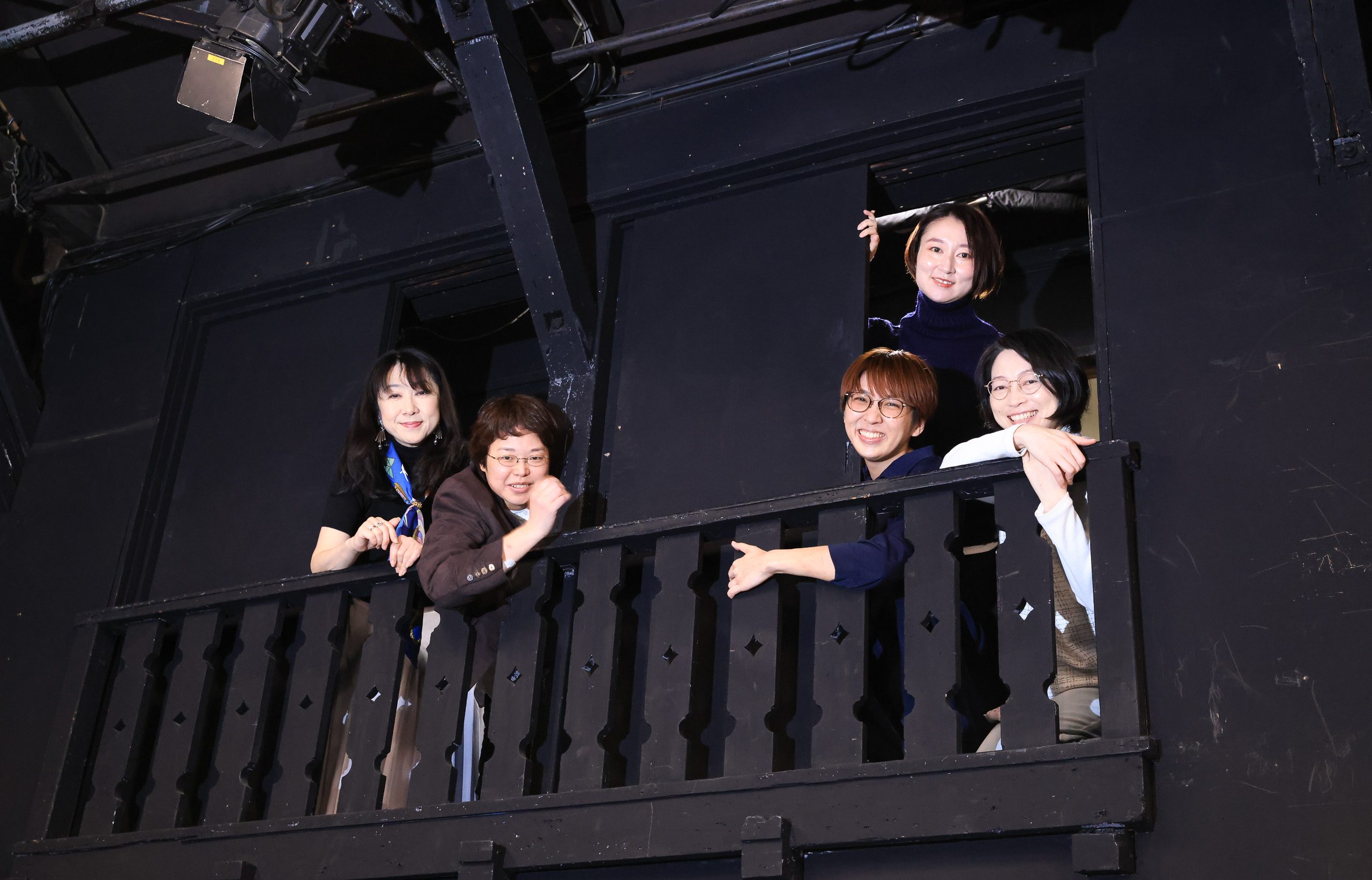
Yuko Matsumoto / Marie Gonohe / Yuka Nishimoto / Kae Inaba / Miyuki Ikuta
Bungakuza Women Part Two: Twenty-First Century Successors to a Hundred-Year-Old Theater Movement
Photo: Maiko Miyagawa / From left to right, Yuko Matsumoto, Yuka Nishimoto, Miyuki Ikuta, Kae Inaba, Marie Gonohe
The longstanding shingeki1 theater company Bungakuza2 is an incubator for directors who go on to have remarkable careers. Is it a coincidence that many of them are women, or the result of the company’s traditions and training system? To solve the mystery, we brought five directors of different generations together: Yuko Matsumoto, Marie Gonohe, Yuka Nishimoto, Kae Inaba, and Miyuki Ikuta. Continuing from Part One, in which the five discussed their individual directing styles, reasons for joining Bungakuza, and the liberating atmosphere in the company, Part Two sees them sharing how they cope with the somewhat harsh reality of being labeled “shingeki” due to their affiliation with Bungakuza. With all the styles available in contemporary theater alone, why did they choose shingeki? What does shingeki mean to each of these women? How does the new wave that hit Japanese theater one hundred years ago influence its twenty-first century descendants today?
Interview/text: Rieko Suzuki
English translation: Claire Tanaka
-
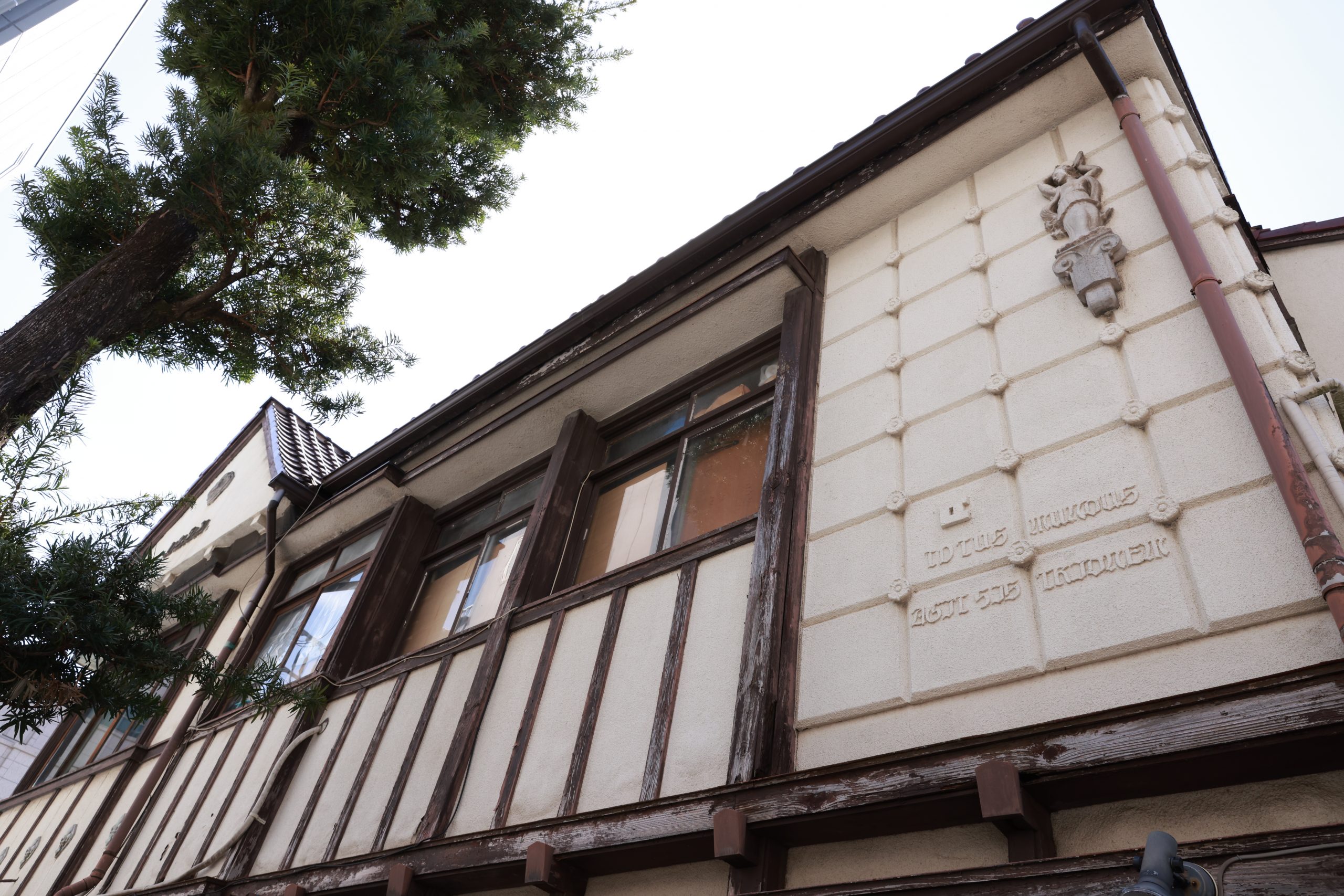
Bungakuza Atelier in Shinjuku, Tokyo
Japan’s contemporary theater scene built the basis for modern theater with shingeki, followed by angura (underground theater), which aimed to exceed what came before through experimentation with physicality and connections with audiences. Next was the shogekijo (little theater) boom in the 1980s with its incorporation of video media, and the gendai kogo engeki (contemporary colloquial theater) that emerged in the mid-1990s, championed by Oriza Hirata, which emphasizes natural speech and restrained acting. These many different styles of theater now exist simultaneously. So, why did all of you choose Bungakuza, with its shingeki pedigree?
Yuko Matsumoto The artists of the generation a little before me who were involved in shogekijo theater in the late 1980s and ’90s like Hideki Noda, Shoji Kokami, and Takeshi Kawamura, are all playwright-directors. I admired them and so tried writing plays, but I guess I just didn’t have the talent for it. Now that I think of it, back then I couldn’t imagine only directing, and at one point was involved in theater on the production side. During those two years, I saw shingeki shows that I had rejected out of hand until then, as well as excellent works from overseas such as Britain’s Royal Shakespeare Company and National Theatre, and I grew to realize that I like plays that have a strong narrative structure and give a sense for the subtleties of the human heart. I moved to Tokyo to go to university and surrounded myself with shogekijo theater and works with angura-type intense dialogue like Juro Karas,3 and I was really moved and impacted by that. But I realized that I didn’t want to direct that sort of work. Then, I encountered a show directed by Hitoshi Uyama4 and I thought, this is who I want to study under. I could tell that Uyama carefully considered how to take an old, musty story and create a work that impacts modern audiences.
-
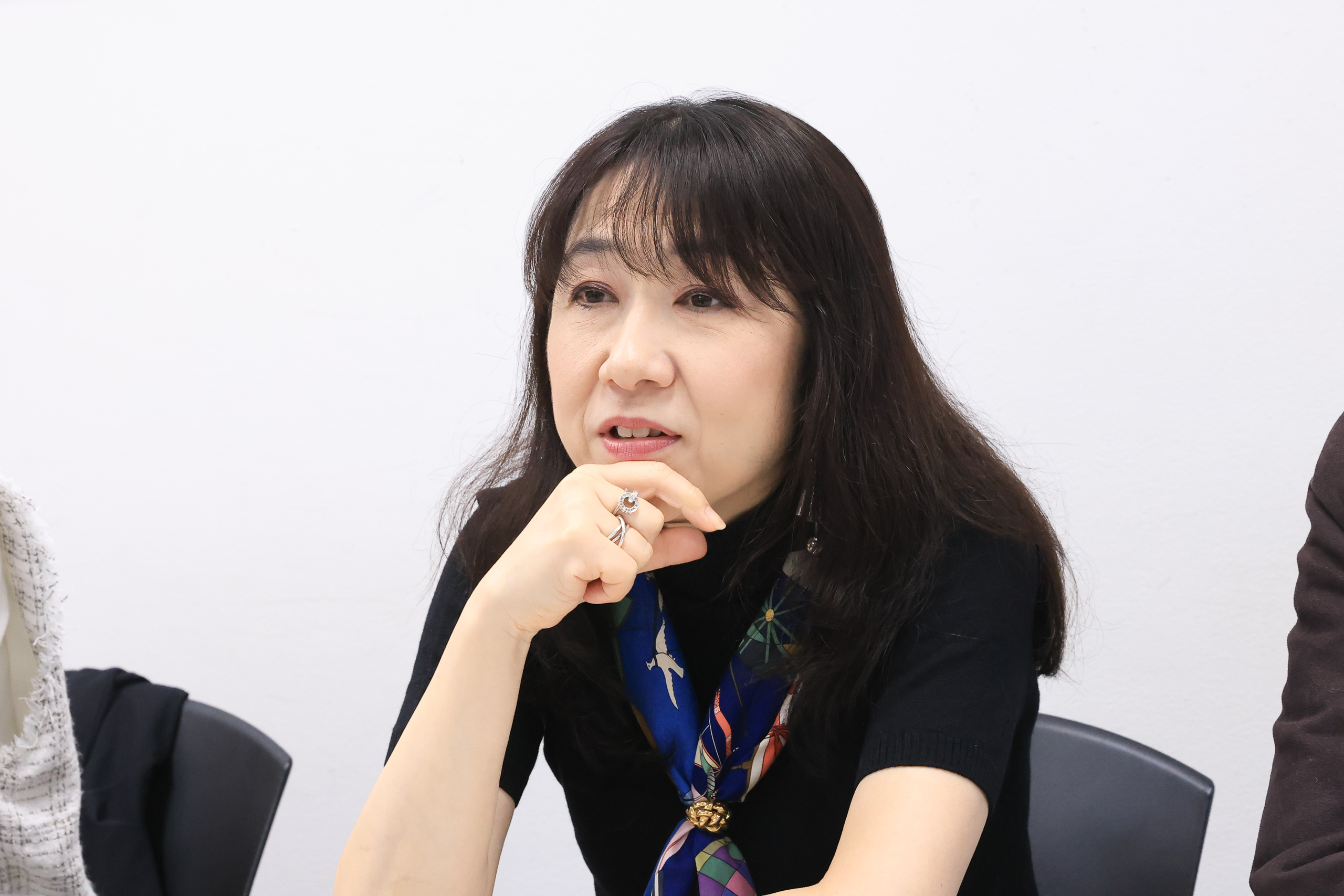
Yuko Matsumoto
Marie Gonohe I wanted to be a playwright and so was writing and directing my own works. But after I founded my company and put on about three shows, I began to realize that it would be difficult to keep at it just by my own effort. I had never studied directing, so I thought I should properly study it. When I was looking into it, Bungakuza just happened to be recruiting trainees and I applied to join without thinking about it too deeply. At first, I figured I’d just spend a year learning and then quit. But with the graduate show for the basic program (the first-year program at the institute), I saw professional staff working up-close for the first time, and I was really impressed when I learned the behind-the-scenes techniques like how stage managers ensure the actors have clear paths to move around backstage. I realized that one year wasn’t enough and decided to stay on for two more and joined the full trainee program, and as a result I’m still here.
-
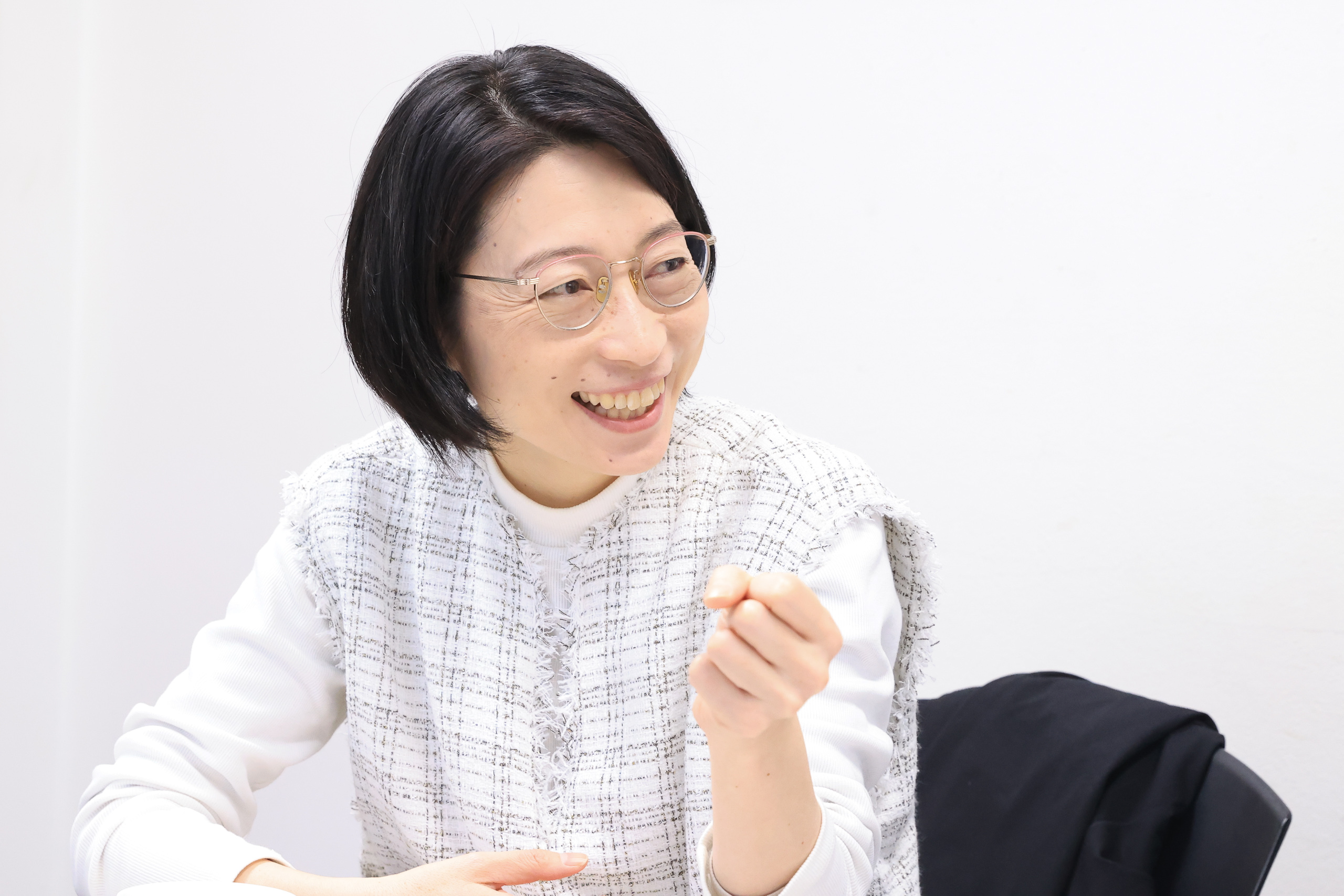
Marie Gonohe
Yuka Nishimoto I also wanted to learn techniques. I studied directing at university, and although I knew that talent and aesthetic sense were important, I also began to understand that this work requires a certain vocational skill that can only be acquired through experience. I chose Bungakuza because it seemed to have accumulated both technique and knowledge. Actually, when I was still in university, a professor had told me that I should join Bungakuza or Seinenza if I wanted to learn such things. Right around that time, I saw a work directed by Hitoshi Uyama and thought it was interesting and that settled it for me.
-
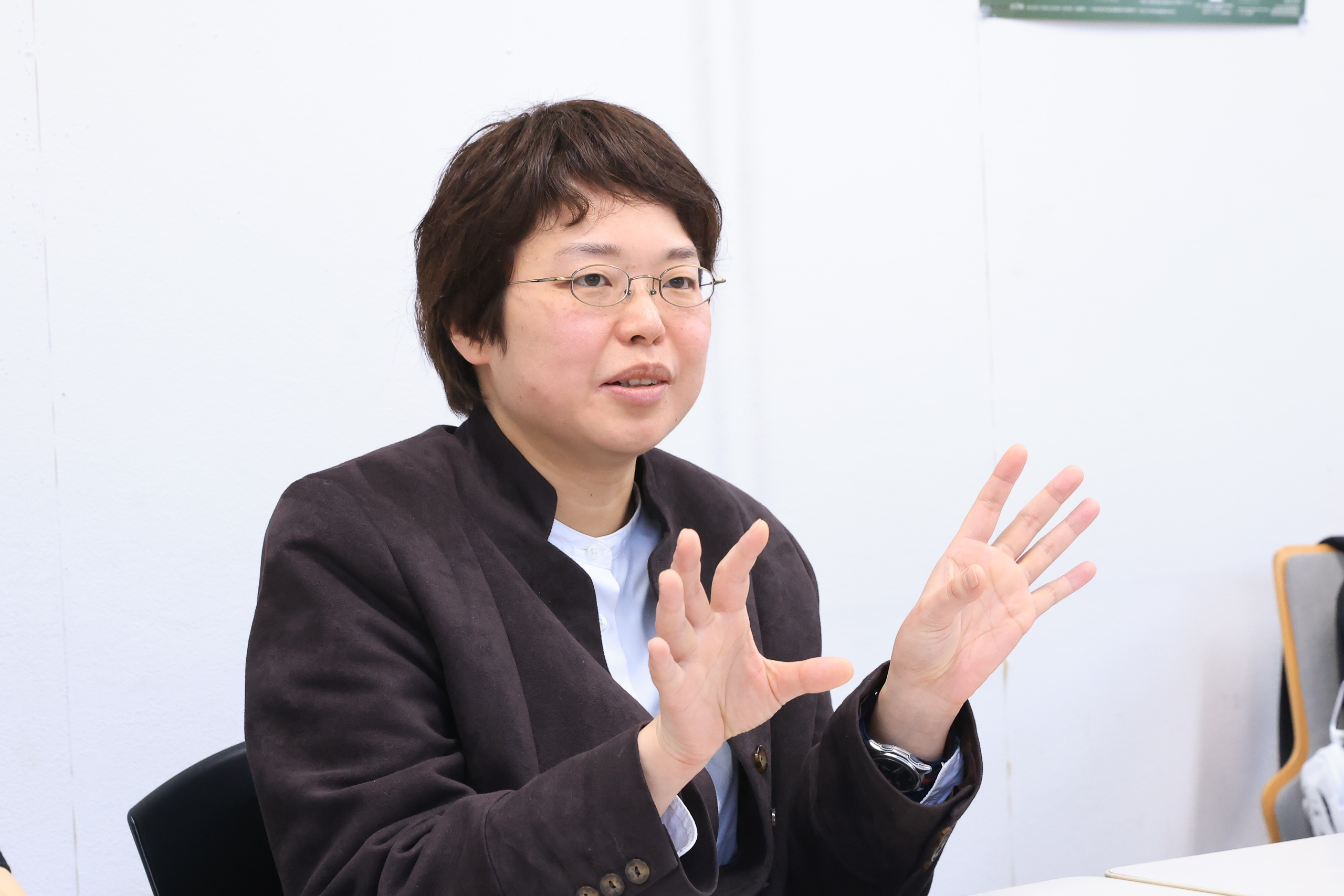
Yuka Nishimoto
Kae Inaba I was in the film program at university. I had originally wanted to be an illustrator, and I loved making things by myself. With film, the footage can live or die depending on the editing, and the idea that a work is made by its director is strong, and that held an attraction for me. But when I actually started doing it, I realized that I preferred rehearsing over filming. I spent so much time fixating on performance that the shoot schedule got delayed and it cost money. The professor who saw the work I finally submitted told me that perhaps the thing I wanted to do wasn’t film after all, but theater. I was introduced to Bungakuza as a place that could teach me that. When I started, I didn’t even know what a script was. I knew nothing about theater and I feel lucky that they let me join. After I joined, I was still in university and didn’t know if I really wanted to do theater or not. I thought I would just get what I could out of it and then make a getaway. But I really enjoyed the directing seminar I took with Uyama in my first year, and Hisao Takase’s5 impactful class on reading scripts gave me the tools to decipher any script. We were reading Masataka Matsuda’s The House on the Hill, and we would think about things like: Why does this scene start with a monologue? How did the characters come into this world? It was so logical, yet had a high degree of freedom, and it got me really excited. Those two experiences were the highlight of my two years in the training program and made me who I am today.
-
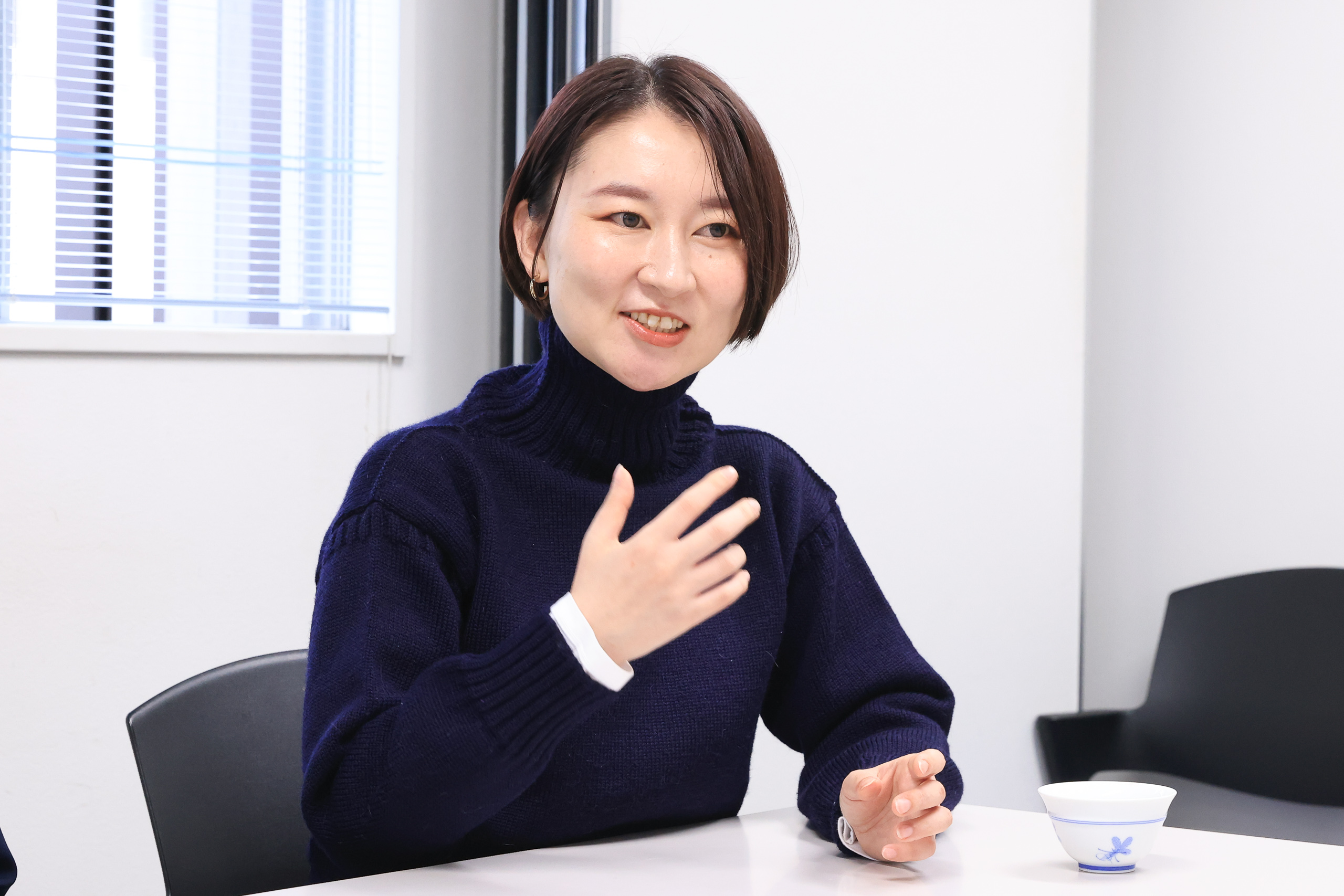
Kae Inaba
Miyuki Ikuta I did theater in my teens, and I had thought about becoming an actor, but even as an amateur I felt a certain limit to my own abilities. I wanted to learn more so I came to Tokyo and my defining encounter was an opera directing workshop I took in grad school. That was the first time I understood that directing was about thinking how to present a work to an audience today, and I thought, this is a job that would be worth trying to do. But my experience in opera was having to do quick rehearsals around the singers’ busy schedules. Since my junior high school days, though, I had always worked on shows where we’d all get together and hash things out, building something together, and to me that’s the true basis for creating something, so I decided it wasn’t opera but theater that I wanted to do. At that time, the director I was most familiar with was Bungakuza’s Nobuhiro Nishikawa.6 At grad school, I joined a project to stage a musical with junior high students from Taito ward, and Nishikawa was there as a sort of observer. He assisted students to whom I hadn’t been able to give my full attention, helping them remember where to stand and so on. He helped arrange the technical flow so that the blocking went smoothly. Until then, I had this image of shingeki as being old, and I disliked it without ever trying it, but I felt an honest sense of wonder at that time. That was when I began to think it would be faster to learn these skills by joining a company rather than going it alone.
-
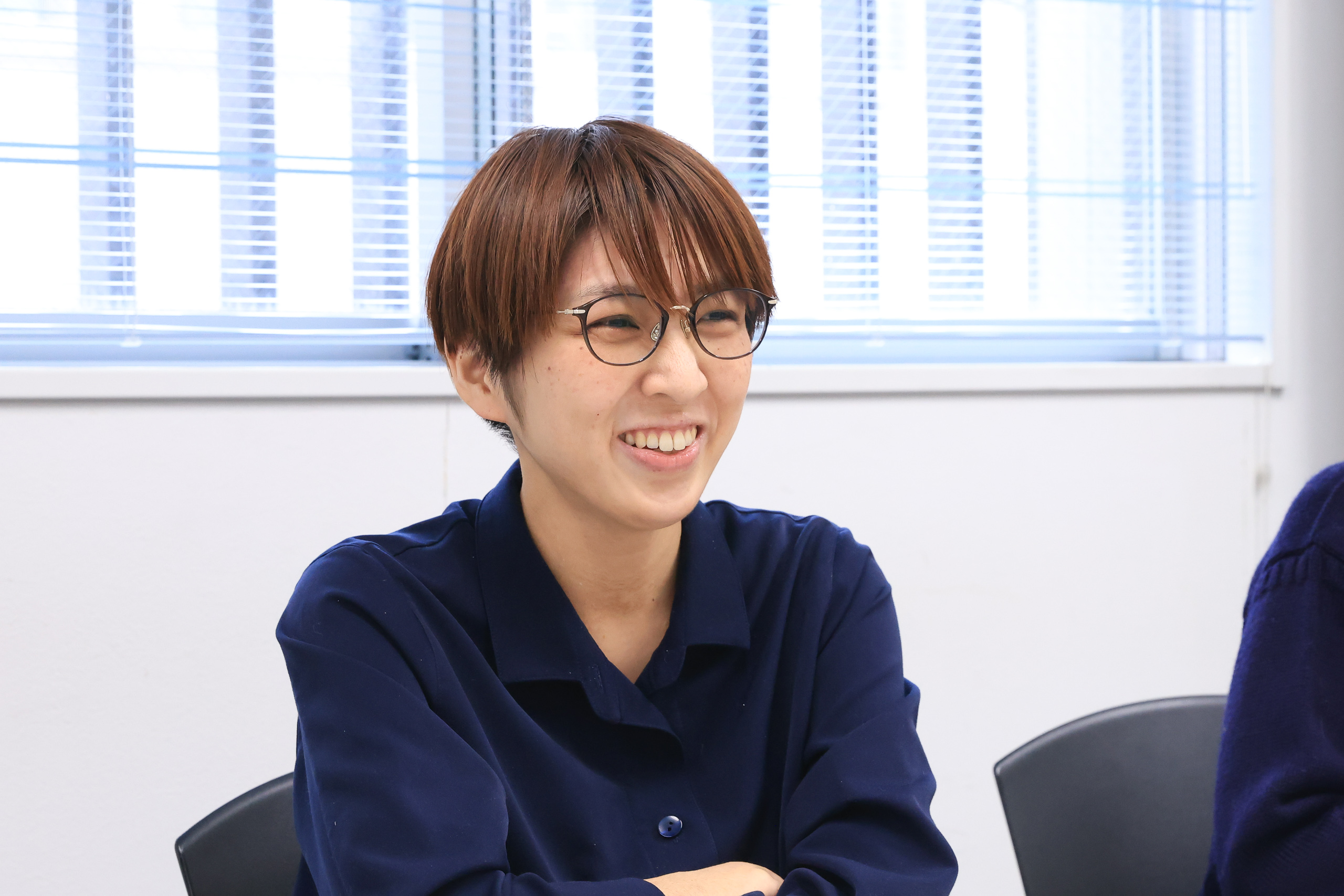
Miyuki Ikuta
It seems as though you were all attracted to the well-established company through the methods and techniques it possessed. What are your thoughts on shingeki and its background and history?
Matsumoto The shingeki movement was a reaction to preexisting theater forms like kabuki, shinpa,7 and shinkokugeki.8 But now, the works we’re staging are not so different from commercial theater or shogekijo plays. I also direct (angura and shogekijo) tent plays, and Inaba has directed works by Shuji Terayama.9 I don’t think there is a need to classify something as shingeki anymore. Shingeki is about making entertaining works to satisfy the intellectual curiosity of modern people, and Bungakuza was where that all started. If that’s how we define shingeki, we don’t have to classify it separately. Consider Shakespeare and Ibsen, as well as famous Bungakuza productions like One Woman’s Life and The Rains of America Will Never Dampen My Sleeve. These all deal with issues relevant to the present day, and what matters is thinking about how to deliver that to contemporary audiences. While we must understand the history of oppression and resistance our predecessors went through during World War II, I think it would be alright to call what we do now simply “contemporary theater.”
-
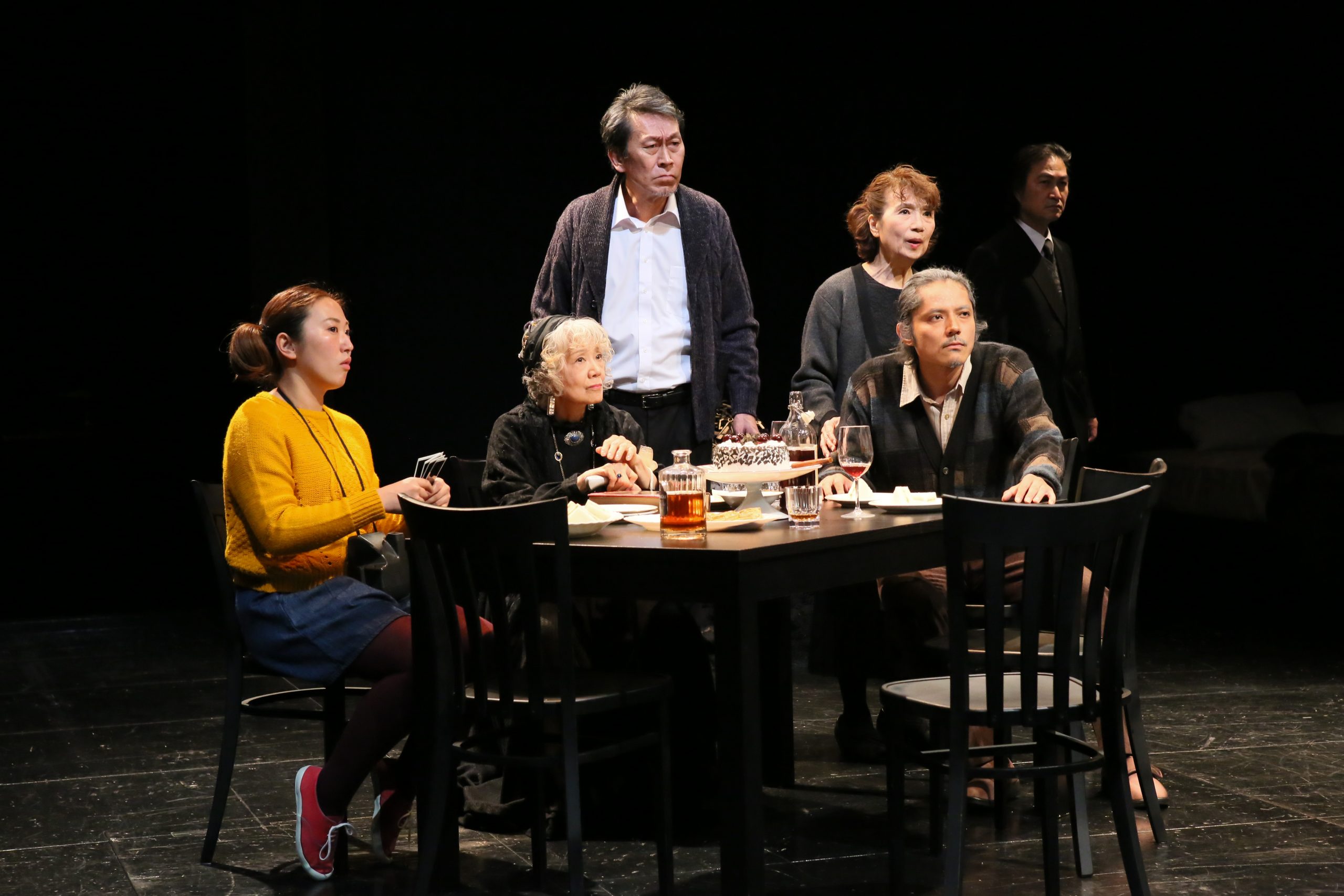
Three Winters, Bungakuza Atelier no Kai, directed by Yuko Matsumoto (September 3–15, 2019). Photo: Maiko Miyagawa
Gonohe We have something we have continued to pass down from the people who first started to call it “shingeki” and perhaps that’s what makes it different from contemporary theater. When making a work as a company, all the members share their opinions. But unlike shows where everyone comes together from other companies and then goes their separate ways again, I feel like those lingering reverberations get stored up. After all, shingeki is a culture that was imported from the West. The question is how to make it fit with Japanese sensibilities. Is shingeki really rooted in Japan at all, compared with, say, kabuki or rakugo? Is it just borrowed culture? I’m always being made to think about such things, and those who came before me thought about it as well. I think the results of that research have accumulated to give us what we have today.
Nishimoto Within the word “shingeki” is the question of how Japanese people have integrated Western culture and literature. I think the answer comes in the process of how it was absorbed, and how have we allowed it to change us personally. That’s why it doesn’t get included in angura, shogekijo, contemporary colloquial theater, and so on. Shingeki has an amoeba-like quality where it rampantly incorporates lots of different things, and actually we have used the writings of so-called angura writers, and of contemporary colloquial theater, and that could be how we’ve evolved. I think this is how we will continue to move forward.
Inaba That’s why shingeki is a movement, not a label to use for works, but that’s gotten mixed up. I’m not going out there promoting myself as a shingeki director, and even if I know shingeki’s history and mindset, it’s not like I’m trying to express my own qualities within that framework. Even so, I get labeled “shingeki” externally. I often get frustrated with the difficulty of explaining it.
Nishimoto I do feel a discrepancy between my understanding and what is seen as shingeki by outsiders. For example, when reciting lines, people tell me that’s shingeki-esque. But I really try not to make it sound like recitation.
Inaba That happens. But then if people tell me, “That doesn’t seem like shingeki,” I’m also like, “Huh?”
Gonohe I think when someone calls me a “shingeki person,” it’s because I’ve said something that they don’t agree with and they’re irritated. But that’s just discriminatory language that judges based on labels, so I let it in one ear and out the other.
-
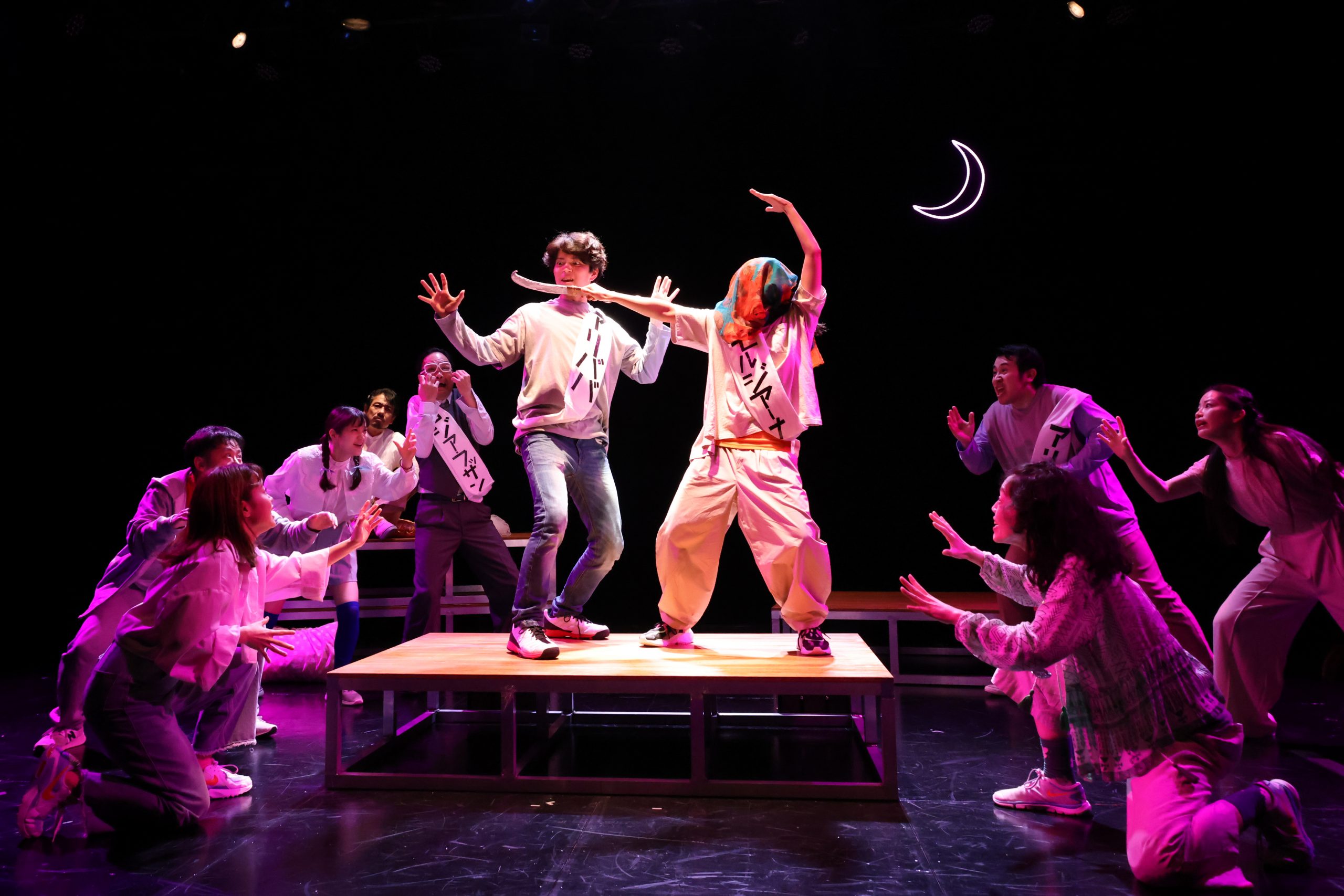
Arabian Night, Bungakuza Atelier no Kai, directed by Marie Gonohe (May 4–18, 2024). Photo: Maiko Miyagawa
Inaba When that happens to me, I ask, “I’m reading it like this right now, but I don’t think it’s very interesting. What do you think?” Even more with people who have different foundations, I ask them how they’re reading the text and we share our ideas and choose. But while going back and forth like that, I find my way of thinking about physicality is still underdeveloped. During rehearsals, I was once told by an actor, “Even if I don’t say that I’m hungry, it’s possible to lean my head to one side and make it look like I’m hungry. That approach might be important.” At first, I thought that way of thinking was opposed to my own and I didn’t want him to use superficial poses, but when I thought deeply about it afterwards, I realized he had told me something really important. That is, the question of whether it could be possible to not only gather the ideas written in the script but also to develop the physical aspects to make things look that way. That is certainly something I’d like to try, but I still don’t have enough physical experience.
-
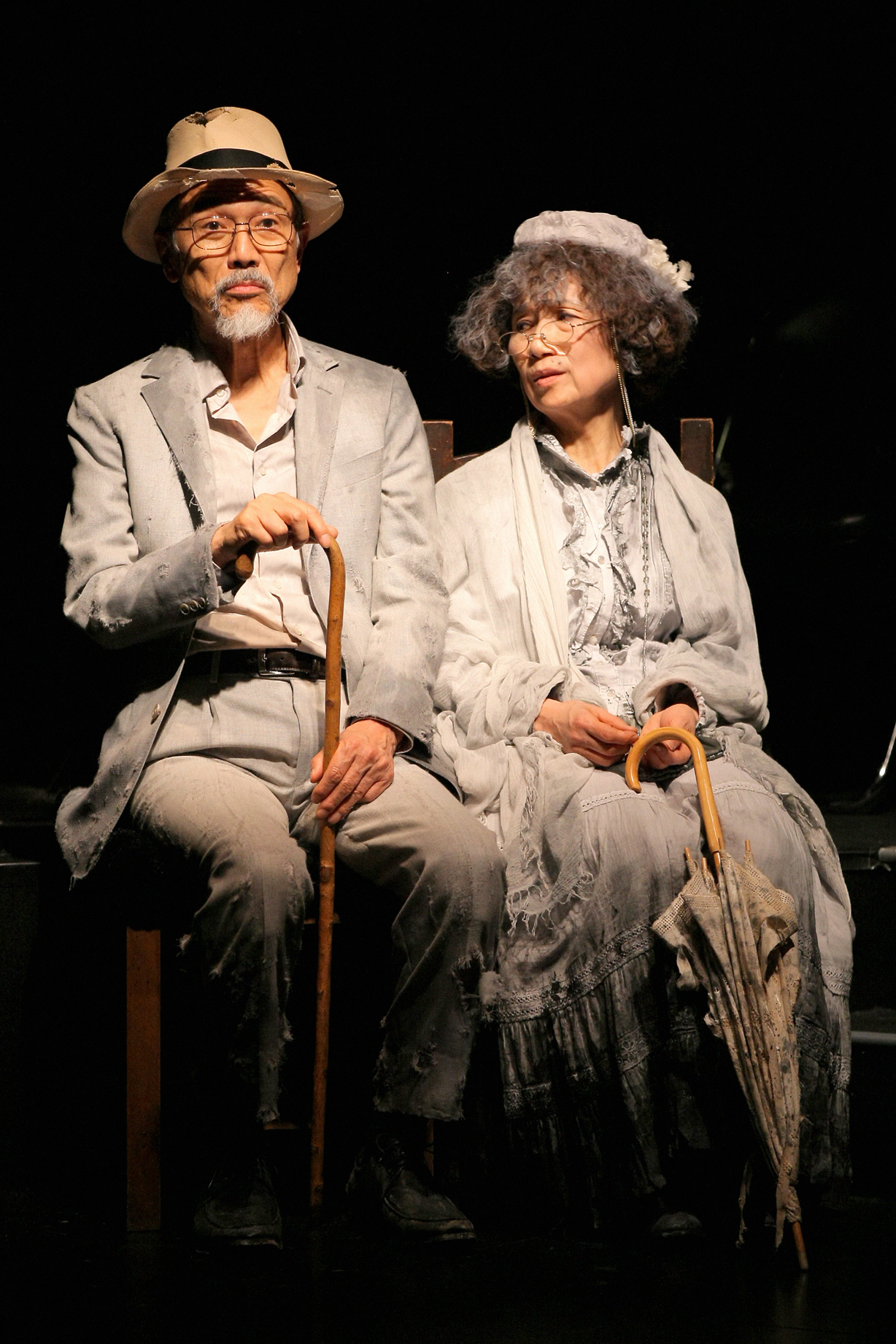
Crossfire, Bungakuza Atelier no Kai, directed by Yoshie Inaba (April 16–30, 2013) Photo: Maiko Miyagawa
Matsumoto The body really does speak volumes, but with Bungakuza actors, they sometimes rely to an extent on expressing themselves without changing their physicality. They try to read and construct the play logically and because of this, they sometimes seem dead from the waist down. I really wonder what suggestion I can make to help them create a livelier presence.
Nishimoto Minoru Betsuyaku once wrote that when audiences watch sumo, their bodies and muscles move, and that is the origin of theater. That really resonated with me. It may be called physicality, but that doesn’t necessarily mean you need to be able to do a lot of fancy moves. Even for people who can’t move well, or have some sort of physical disability, I think what matters is making the audience sit up and resonate with the performance. Actually, in Gonohe’s production of Kaji(Rudder), the sight of the actors in the scene change where they moved each tatami one at a time remains in my memory to this day.
Gonohe There are a lot of theater genres, but at any rate there’s no rule saying a work has to fit into a certain set of specs. It’s alright to be freer with it. It’s alright to have a Bungakuza play where actors are running all over, yet nor do they have to just run around. Of course, as a theater company, Bungakuza has its traditions, and to move even a single tatami mat, you have to search desperately for the right words to convince your superiors why you absolutely must do it. But that might be a good thing. If you’re just trying to do something new and promote the novelty, it’ll be too obvious. I feel like I’m in an environment where I can align with what has been cultivated up to now and to present my ideas in balance with that.
Matsumoto trained in London, and Nishimoto and Ikuta trained in Germany, and all of you have directed a lot of foreign plays. What do you all think now about your relationship with foreign plays, which were once considered an “imported” commodity?
Matsumoto I plan to continue pursuing encounters with new playwrights, regardless of their country of origin, as well as those that are not yet well known in Japan. Like Nishimoto said, it’s important for us personally to grow and change, incorporating things without restraint.
Nishimoto Even if I wanted to put on cutting-edge contemporary plays from overseas, I have to think about what it means for a Japanese person to do so at this moment. In particular, many playwrights these days are writing as stakeholders in actual issues specific to their region. I feel like lately there is an increasing number of such plays where you really have to stop and think about whether it could be put on in Japan at all.
-
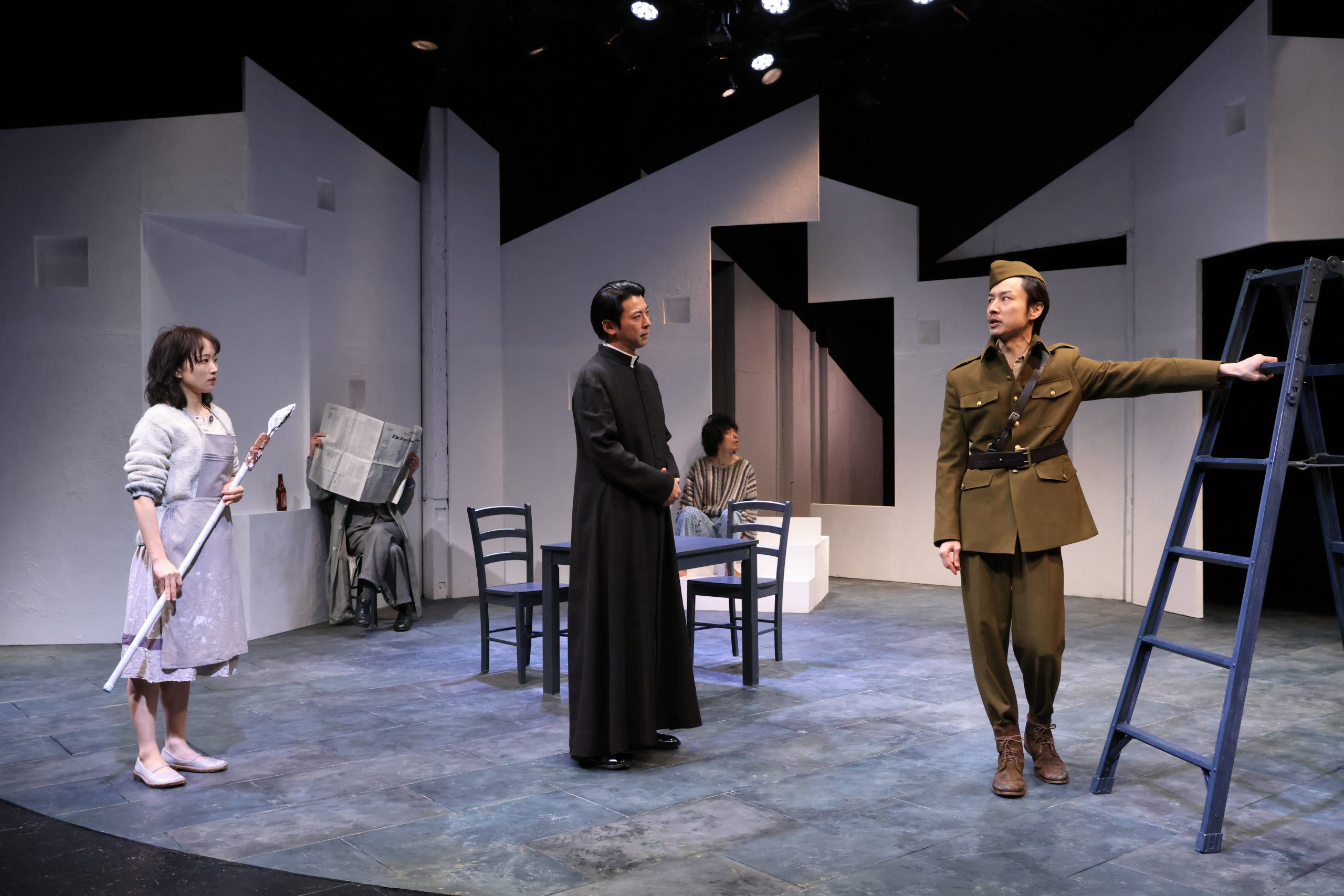
Andorra, Bungakuza Atelier no Kai, directed by Yuka Nishimoto (March 11–26, 2024). Photo: Maiko Miyagawa
Inaba Works that are really personal or specialize in a single theme are certainly difficult. I’m a director, so I incorporate a different perspective from the playwright, a little like translation. For me, I really value the perspectives of writers from around the 1930s to the ’50s, who experienced the world wars and wrote profound plays which enable that “translation” process. Lately, the individual lines in plays out of Europe tend to be getting shorter. That’s another thing that makes it really hard.
Ikuta For me, communicating what is happening simultaneously around the world is one motivation for doing theater. Of course, universality is important, but you can’t ignore individuality either. The urge to feel and empathize universally can result in a dampening of the incidents and thoughts that are written in the play. This problem may be solved in ten or a hundred years, but it is certainly an issue now. What matters is expressing outside perspectives to people in our own contemporary age, and that is one important role that theater plays. Prisoners of the Occupation, the work that I staged in February 2023, was based on what has happened over the past seventy-five years in Palestine. Its story is fundamentally rooted in that history, and conveying such was one mission of the show. It may not have a very strong influence as a medium, but I believe theater has the ability to move people through that experience of a performance together in close quarters and that is why I want to make theater.
-
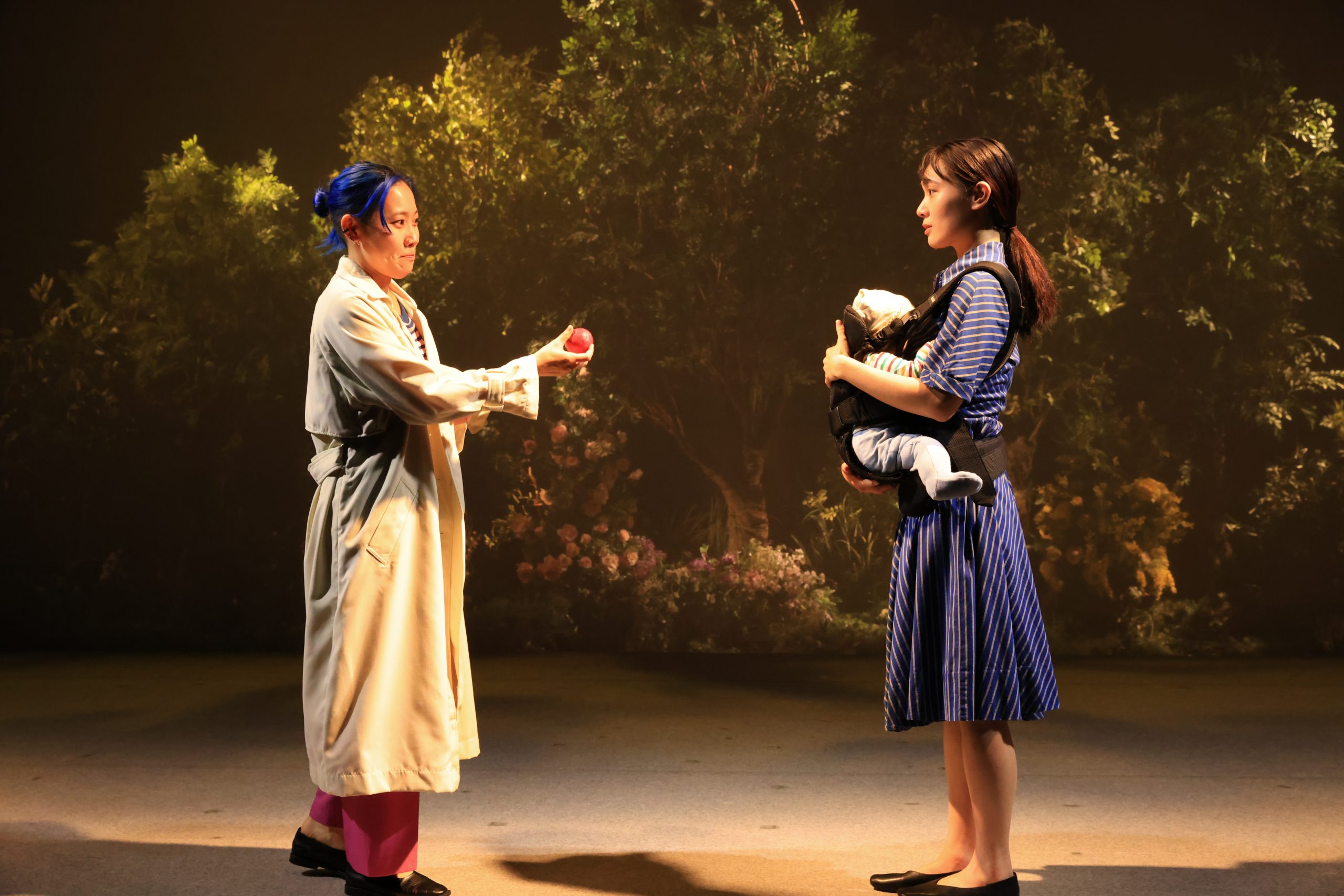
Anatomy of a Suicide, Bungakuza Atelier no Kai, directed by Miyuki Ikuta (September 11–23, 2023). Photo: Maiko Miyagawa
Today we spoke about the nature of the theater company and of shingeki as a category, and I think we had a very frank conversation. I understand it’s rare for all five of you to be together, but the way you’re able to have such a lively conversation despite having such different experiences and ways of thinking surely comes from the culture of dialogue, trust in words, and spirit of inquiry within your company. Thank you for sharing this valuable conversation
with us today.
-
Shingeki
At the start of the twentieth century, kabuki and other existing Japanese theater styles were labeled “old theater” (kyugeki), and the contemporary theater that was born to reflect the new modern era was called “new theater” (shingeki). It is a theater of realism, and at first mainly comprised productions of translated foreign, mostly European, plays. Shingeki advocated for a noncommercial form of theater not swayed by the capitalist aims of entertainment. Along with this emphasis on artistry, it became connected with left-wing movements as theater for the people opposed to the bourgeoisie. After World War II and the Red Purge, its politics diminished, and theater companies like Bungakuza, Haiyuza, and Mingei competed to develop highly individual styles and reached the peaks of their popularity. In the late 1960s, a new, anti-shingeki movement emerged, and eventually usurped shingeki’s place as the mainstream of contemporary theater in Japan. With new talent appearing in recent years, though, the image of shingeki seems to be changing.
-
Bungakuza (Bungakuza Theatre Company)
In 1937, the Bungakuza Theatre Company was established by three literary figures (Kunio Kishida, Mantaro Kubota, and Toyo Iwata). Within Japan’s shingeki movement, which emphasized textual interpretation due to the influence of modern Western theater, Bungakuza particularly emphasized literature and artistry, while also collaborating with the playwrights of the era. The company is known for being the first to bring the works of Tennessee Williams and Thornton Wilder to Japan. The affiliated actors institute trains actors and staff, and their Atelier is also well-known for its experimental theater performances. https://www.bungakuza.com/index.html
-
Juro Kara
The playwright, director, novelist, and actor Juro Kara was born in 1940. In 1963, he founded Gekidan Situation no Kai (Theater Company Situation Association) and the following year he changed the name to Jokyo Gekijo (Situation Theater). Starting in 1967, he began staging plays he wrote and directed in a mobile tent theater he called the Aka Tent (red tent). He established a unique artistic vision where vulgar reality and fantasy intertwined, sublimating into poetry, and prioritizing the physicality of individual actors over the script. His charismatic personality made him a symbol of the late-1960s angura theater movement, and he continued to exert great influence over Japan’s contemporary theater artists in the following decades. He died in 2024.
-
Hitoshi Uyama
Theater director Hitoshi Uyama joined Bungakuza in 1982. He was the artistic director for drama at the New National Theatre, Tokyo from 2007 to 2010. A trusted veteran of the stage with a broad range of work, he has directed many of Shakespeare’s history plays including the Henry VI trilogy, much of Hisashi Inoue’s works, as well as operas and musicals. He has been Chairman of Bungakuza since 2024 .
-
Hisao Takase
The director Hisao Takase joined Bungakuza in 1985. He personally adapted The Count of Monte Cristo, and brought foreign plays like Skylight, and Our Class to the stage in Japan, as well as many works for children like The Arabian Nights. He died suddenly in 2015 at the age of fifty-seven.
-
Nobuhiro Nishikawa
Nobuhiro Nishikawa is a director who joined Bungakuza in 1981. In addition to directing company productions, he has also produced a wide variety of Japanese and foreign plays outside the company, including commercial theater shows for large venues. He is the vice director of the New National Theatre Drama Studio, a guest professor at Tokyo University of the Arts, and chair of the Association of Japanese Theatre Companies.
-
Shinpa (geki)
Shinpa (geki) (literally, “new group (theater)”) is a type of modern drama influenced by kabuki. At the end of the nineteenth century, activists in the Freedom and People’s Rights Movement started it as a new popular theater form to replace kabuki. It features many famous tragic love stories such as Konjikiyasha (The Golden Demon) by Koyo Ozaki. Gekidan Shinpa performs the shinpa repertoire to this day, continuing to depict the realistic lifestyles, cultures, and vernaculars of Japan’s Meiji, Taisho, and Showa eras in which the plays are set.
-
Shinkokugeki
Shinkokugeki (literally, “new national theater”) was a theater company founded by actor Shojiro Sawada in 1917 with the goal of creating a new national theater. With the motto of “Art to the right, the masses to the left,” it staged popular dramas that appealed to a broad audience, taking the nation by storm particularly with its chanbara plays that featured impressive swordplay. Compared to shinpa, which attracted female audiences with its melodramatic plays, Shinkokugeki’s plays focused on stories of gangsters and social issues, and were enjoyed by mainly male audiences. The company disbanded in 1987.
-
Shuji Terayama
Shuji Terayama was a poet, playwright, theater director, screenwriter, and film director. He exercised his talents in many ways, from tanka poems to essays about horse racing. He founded the Tenjo Sajiki experimental theater group in 1967, a contemporary to Juro Kara’s Jokyo Gekijo. In 1969, he was invited to the third iteration of Experimenta, Frankfurt’s international festival of experimental theater, becoming the first to stage a Japanese contemporary play overseas, to critical acclaim. From then until Terayama’s death in 1983, when Tenjo Sajiki disbanded, the company performed in dozens of cities across Europe and North America.
-
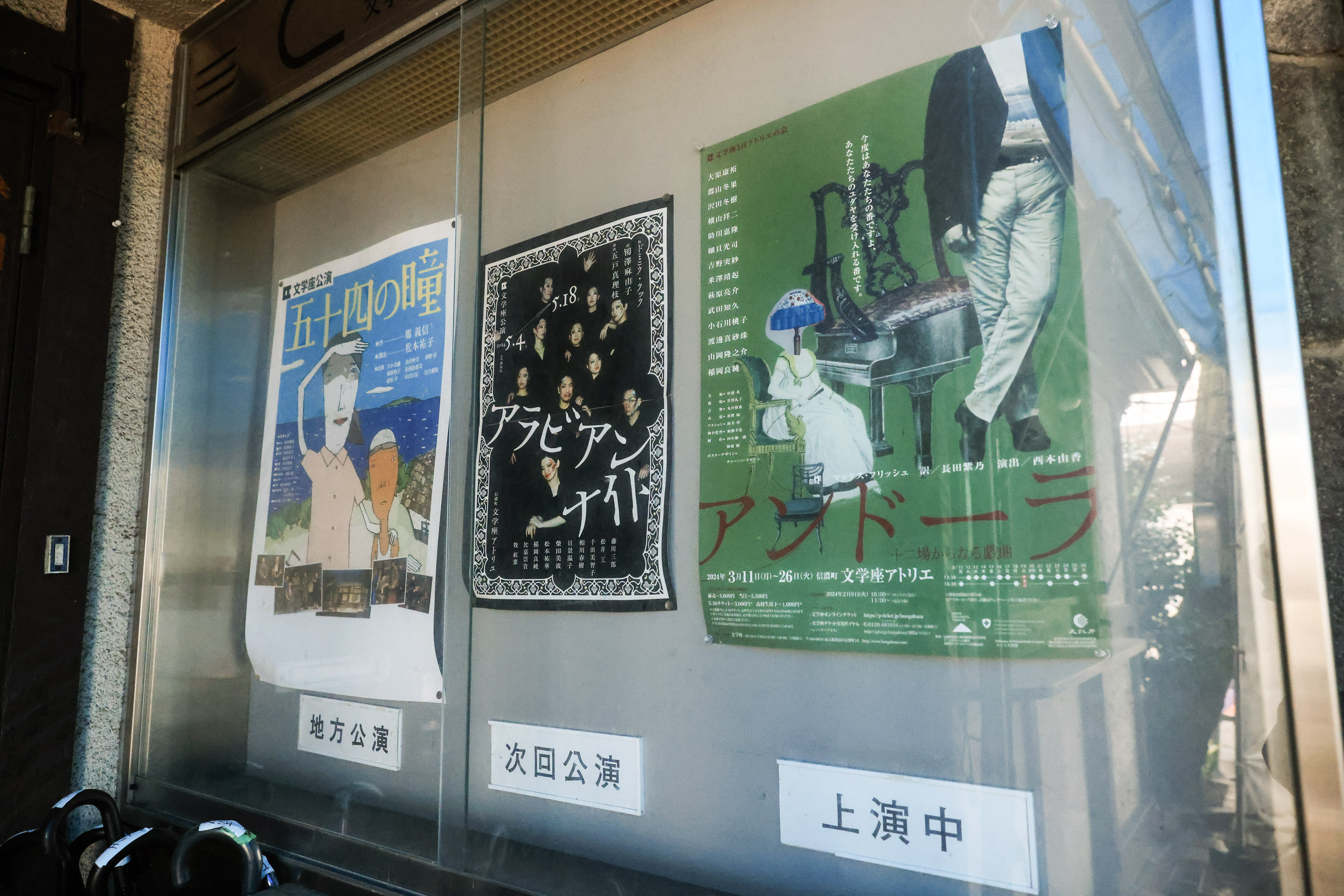
Bungakuza Atelier with posters from left to right, Fifty-Four Eyes (on tour) directed by Yuko Matsumoto, Arabian Nights (coming soon) directed by Marie Gonohe, and Andorra (now showing) directed by Yuka Nishimoto.
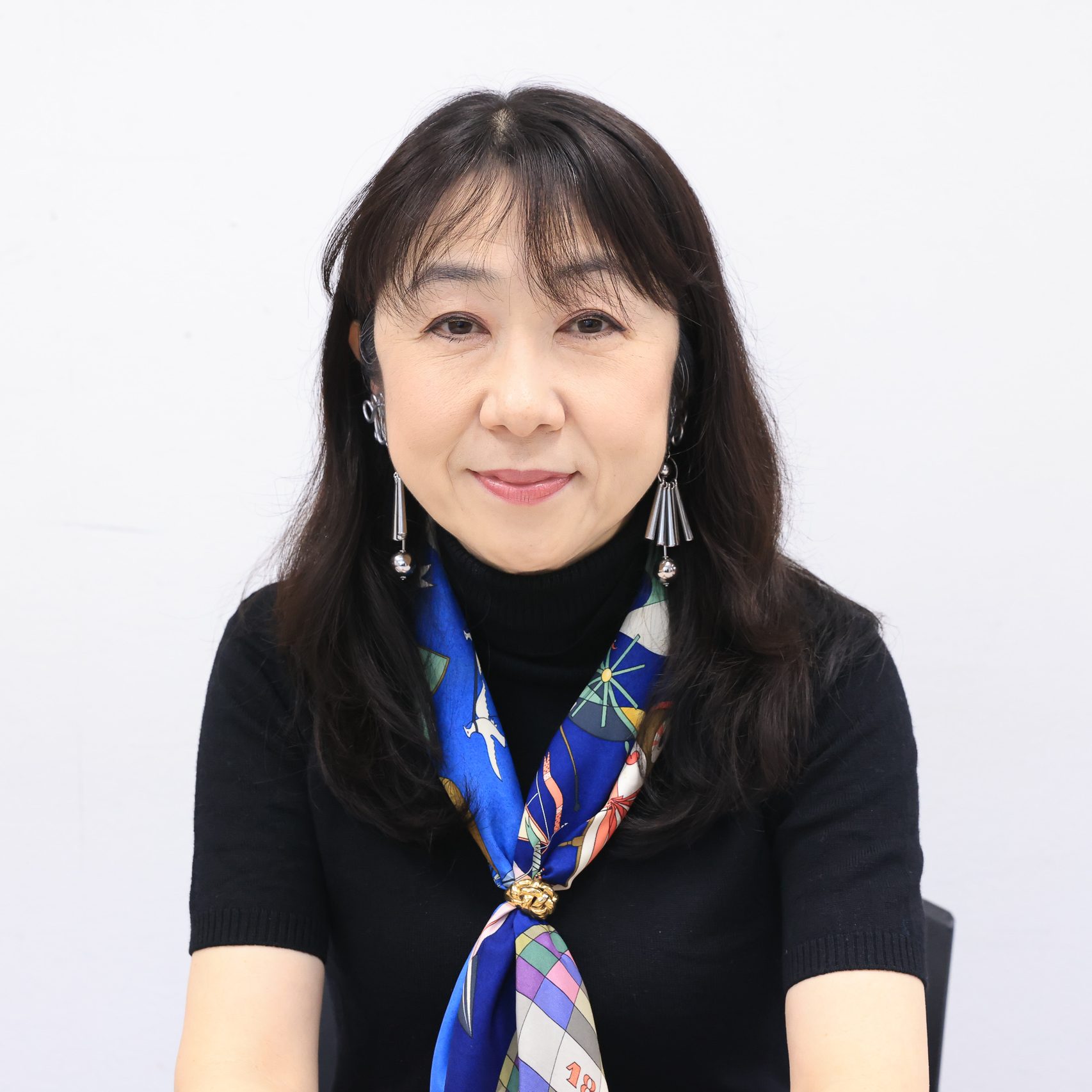
Photo: Maiko Miyagawa
Yuko Matsumoto
Born in Hirakata, Osaka, in 1967, theater director Yuko Matsumoto graduated from Meiji University’s Department of Literature with a major in drama and theater arts. She joined Bungakuza Actors Institute in 1992 and was promoted to full member in 1997. In 1999, she studied in London for one year on the Agency for Cultural Affairs Program of Overseas Study for Upcoming Artists. Her first production after returning to Japan, Pentecost, was awarded the 2002 Yuasa Yoshiko Prize, which is given to the best staging of a translated foreign language stage play. In 2006, she won the Mainichi Art Award Senda Koreya Prize for Nukegara (Bungakuza Atelier no Kai) and Peter Pan (Horipro). In 2019, Matsumoto won the Kinokuniya Drama Award for Personal Achievement and Excellence in Directing at the Yomiuri Theater Awards for Hito wa mina, Hitonamino (Matchpoint) and Three Winters (Bungakuza Atelier no Kai), and in 2020 won the Minister of Education, Culture, Sports, Science and Technology’s Art Award for Fifty-Four Eyes (Bungakuza).(Updated July 2024)
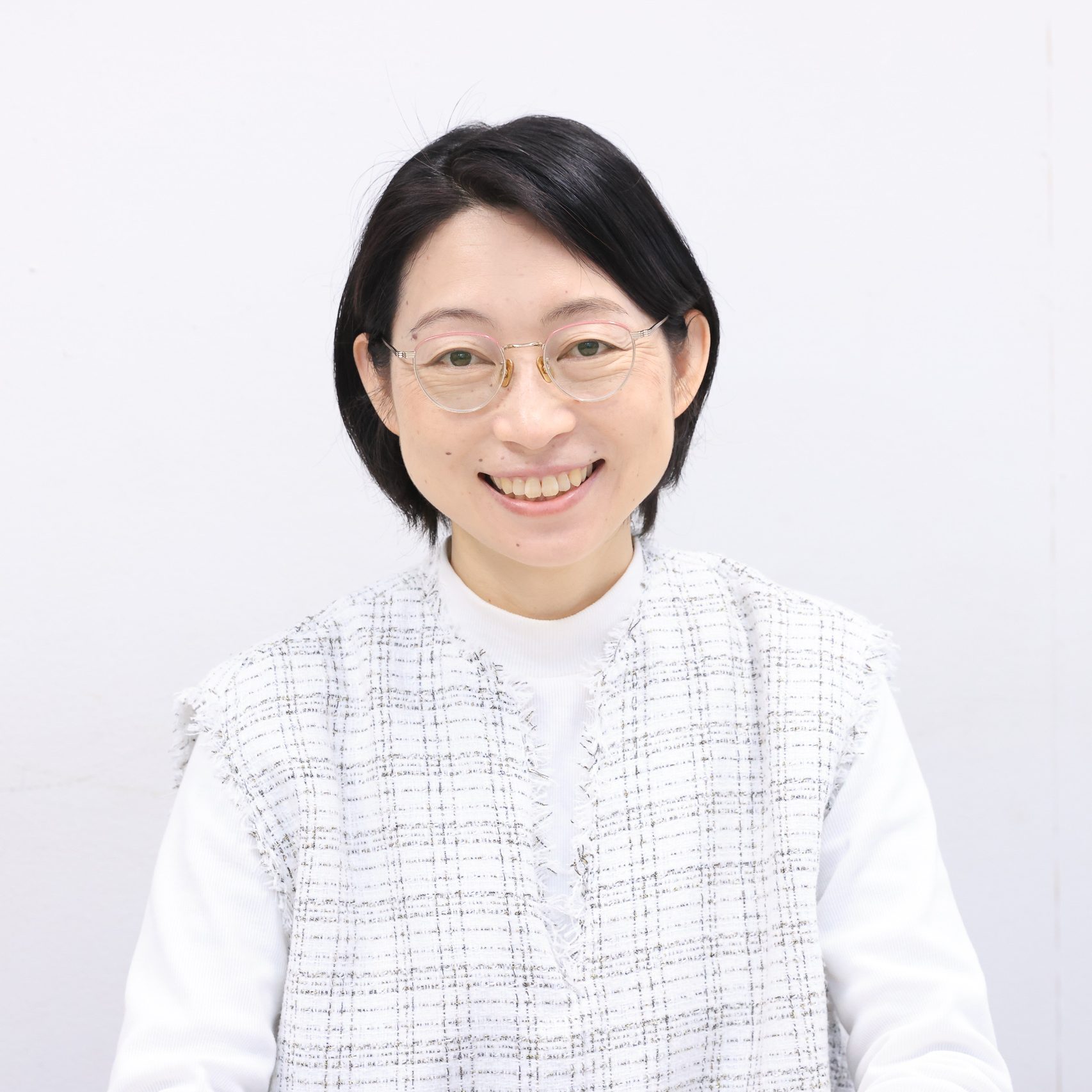
Photo: Maiko Miyagawa
Marie Gonohe
The director and playwright Marie Gonohe was born in Sanda, Hyogo. She graduated from Waseda University’s School of Humanities and Social Sciences with a major in theater and film arts. She founded her own theatre troupe and took part in small stage theater before joining Bungakuza Actors Institute in 2005. In 2010, she became a full member of Bungakuza. In 2016, she directed her first play for Bungakuza, Kaji/Rudder in the double bill Kadode/Kaji (Bungakuza Atelier no Kai). In addition to directing, she also writes plays and children’s stories. Plays she has directed at Bungakuza include The New Hamlet (reading) in 2014, Two Men at Play with Life (independent project) in 2021, Coffee to Ren’ai (adaptation and direction) in 2022, and Arabian Nights (Bungakuza Atelier) and Ishi o Arau (Bungakuza Atelier no Kai) in 2024. She directs many works outside of Bungakuza as well, such as Maxim Gorky’s The Lower Depths for the New National Theatre, Tokyo in 2019. In 2023, Gonohe won Excellence in Directing at the Yomiuri Theater Awards for Coffee to Ren’ai, The Visit (both at the New National Theatre, Tokyo), and Venus in Fur (Setagaya Public Theatre). (Updated July 2024)
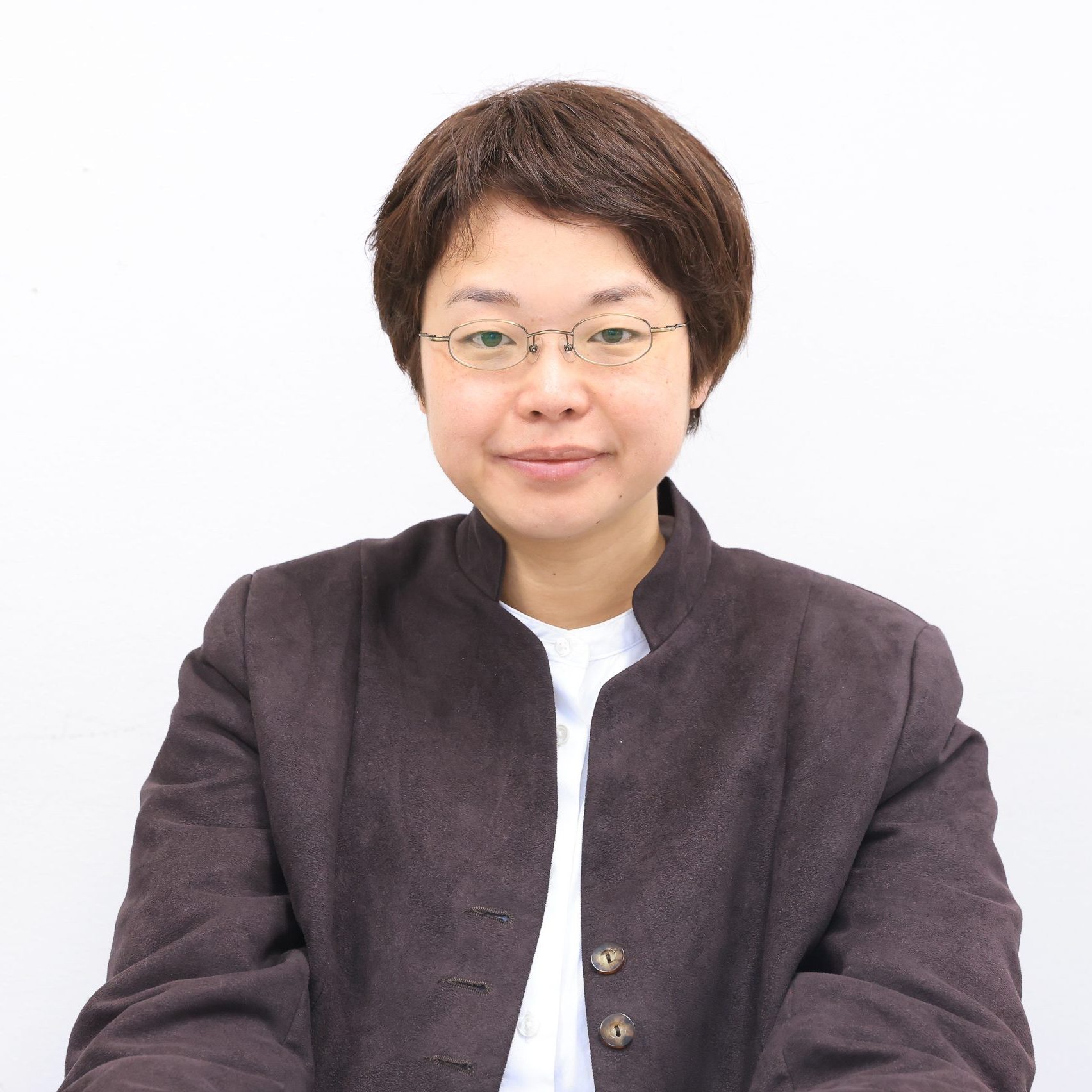
Photo: Maiko Miyagawa
Yuka Nishimoto
The director Yuka Nishimoto graduated from the Theater Program Director’s Course at Nihon University College of Art. In 2006, she joined the Bungakuza Actors Institute, and became a full member in 2012. Her first play directed at Bungakuza was A Day in the Death of Joe Egg (Bungakuza Atelier no Kai) in December 2018. In 2019, she went to Germany on the Agency for Cultural Affairs Program of Overseas Study for Upcoming Artists, and spent a year training in Berlin at the Maxim Gorki Theater and Schaubühne. Recent directing work includes A Space of Time (Bungakuza Atelier no Kai), Sick (Theatre Office Natori), Sabiiro no Mokuba (Gekidan Galba), At the Black Lake (Association of Japanese Theatre Companies), and Andorra (Bungakuza Atelier no Kai) (Updated July 2024)
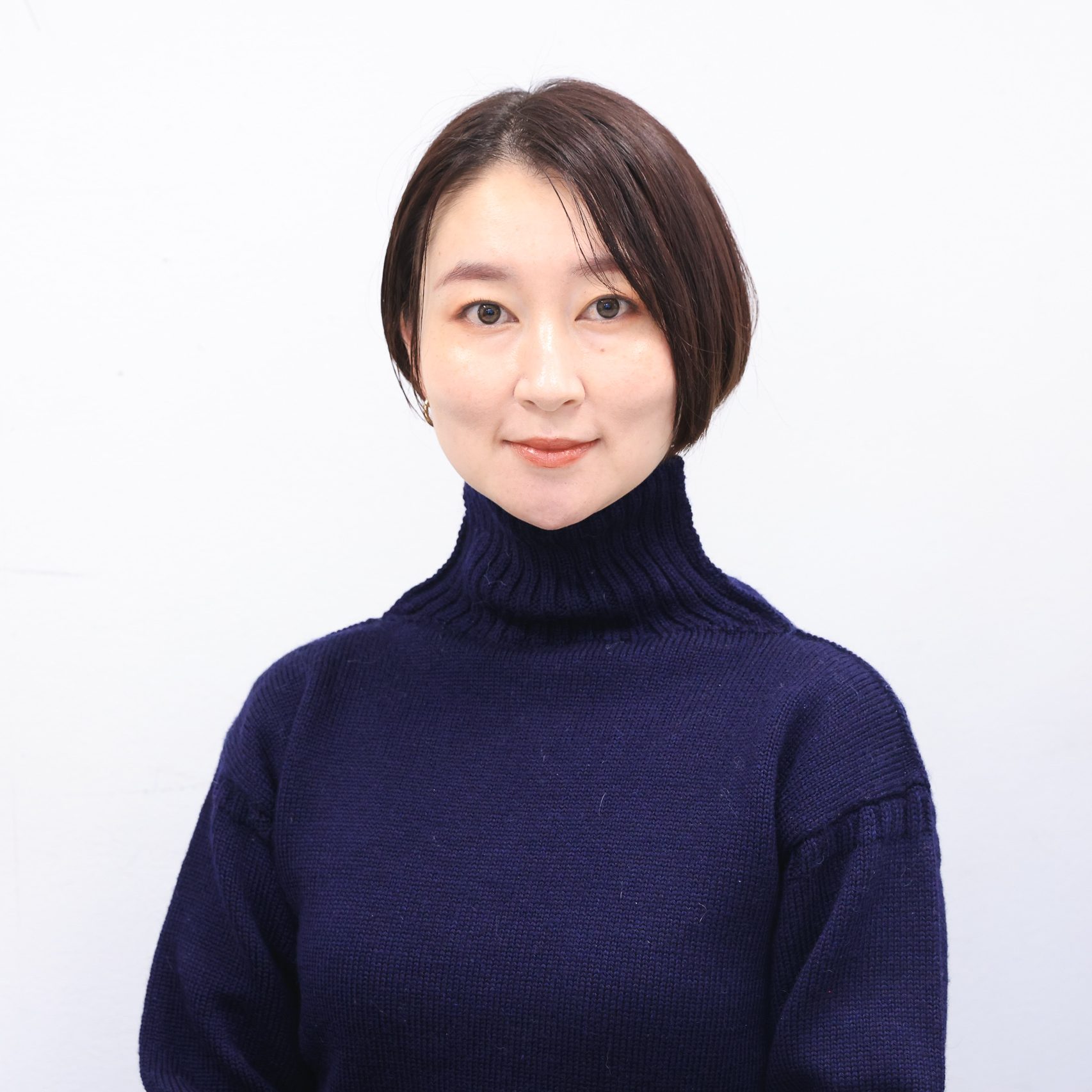
Photo: Maiko Miyagawa
Kae Inaba
The director Kae Inaba graduated from the Film Program Director’s Course at Nihon University College of Art. She began making films while still in school. After joining Bungakuza in 2008, she became a full member in 2013, and in April made her directing debut at Bungakuza Atelier no Kai with Crossfire. Major directing credits include The Wild Duck and The Atami Murder Case (Bungakuza Atelier no Kai), The Misunderstanding and My Month (New National Theatre, Tokyo), Women in Blue Stockings (Piccolo Theater), The Unburied Dead, The Mother, and The Physicists (Office Cottone). Recent directing includes The Unburied Dead (PARCO), Breaking the Code (Gorch Brothers), It’s not a bad thing that people around the world fall into a crevasse, Strange Snow, and Shuji Terayama Version of Lysistrata – Eros in Wonderland (Mixzone). In 2023, Inaba won Best Director at the Yomiuri Theater Awards for The Physicists and The Ghost is Here. (Updated July 2024)
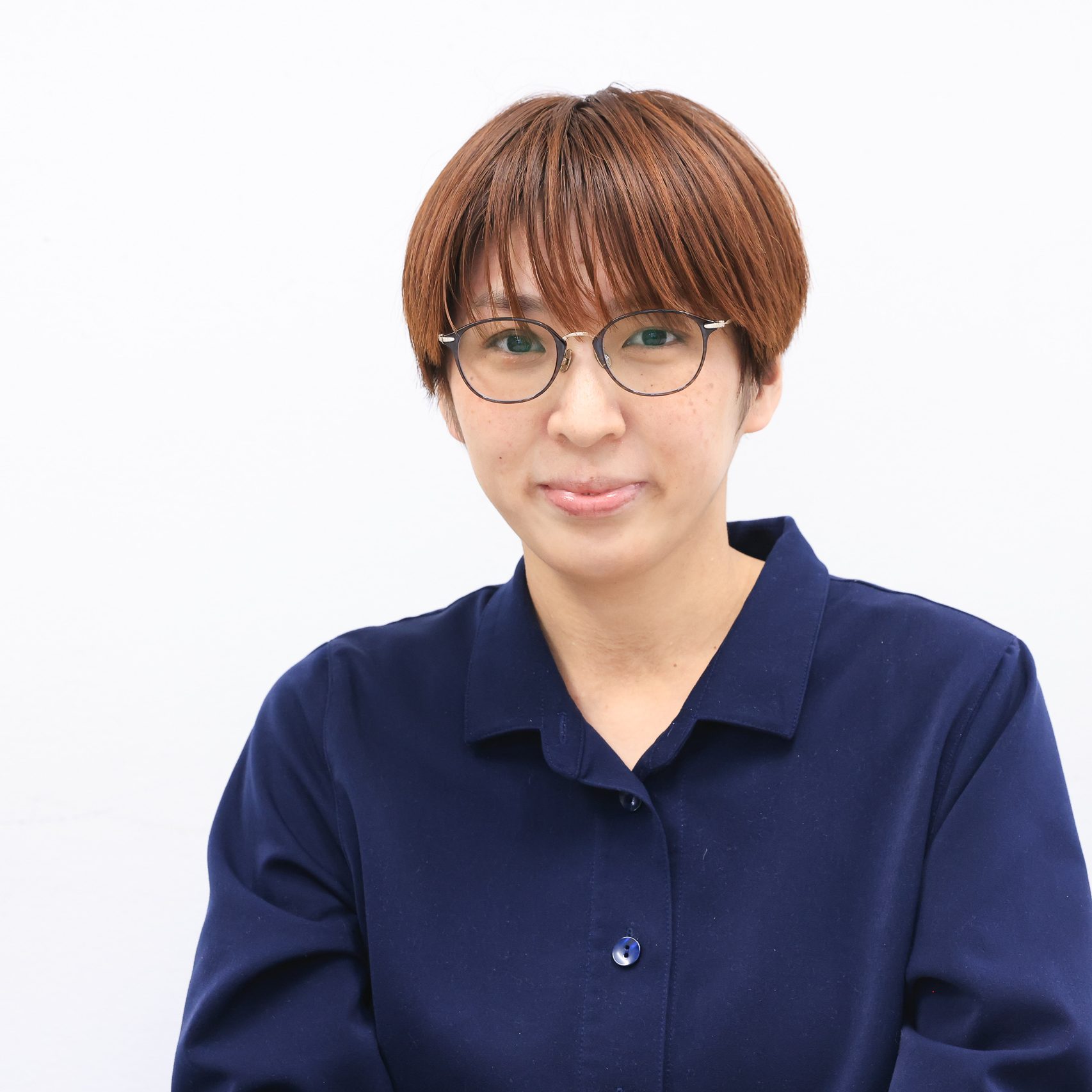
Photo: Maiko Miyagawa
Miyuki Ikuta
The director Miyuki Ikuta was born in Osaka. She graduated from the Graduate School of Music at Tokyo University of the Arts, entering the Bungakuza Actors Institute in 2011 and becoming a full member in 2016. The same year, she went to Germany on a language study scholarship with the Goethe Institut Culture Program. In 2017, she directed her first play for Bungakuza, Hato ni Mizu o Yaru (Bungakuza Atelier no Kai), followed by The Last Fire in 2018 and Girls in Crisis in 2020. She also began working as a member of the theater group Riseiteki-na-Henzentachi in 2018. In 2023, Ikuta won Best Director at the Yomiuri Theater Awards for her Palestinian Theater Performance Series Prisoners of the Occupation (Theatre Office Natori), Naval Encounter (Riseiteki-na-Henzintachi), and Butcher (Theatre Office Natori), and also won the Minister of Education, Culture, Sports, Science and Technology’s Art Encouragement Prize for New Artists for Prisoners of the Occupation, Anatomy of a Suicide (Bungakuza Atelier no Kai) and more. (Updated July 2024)




